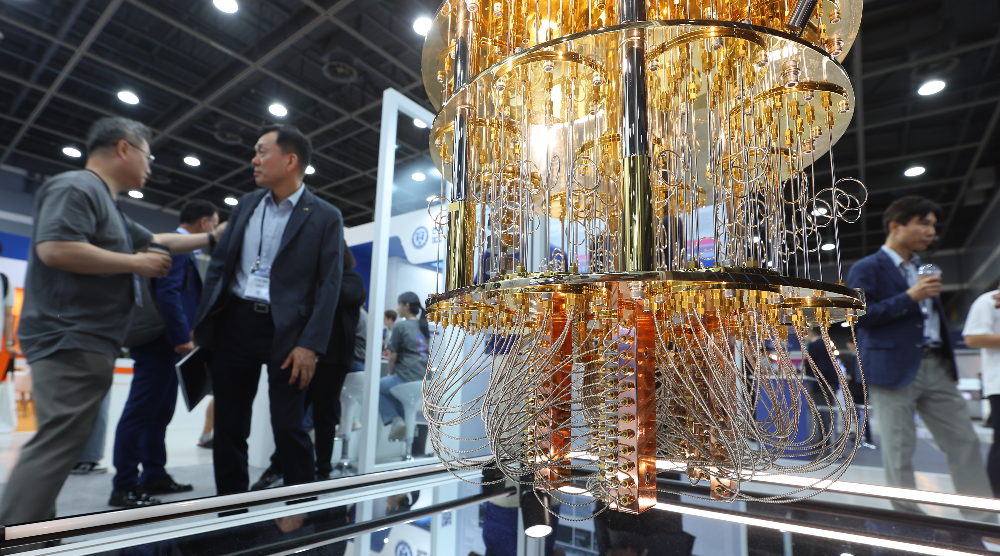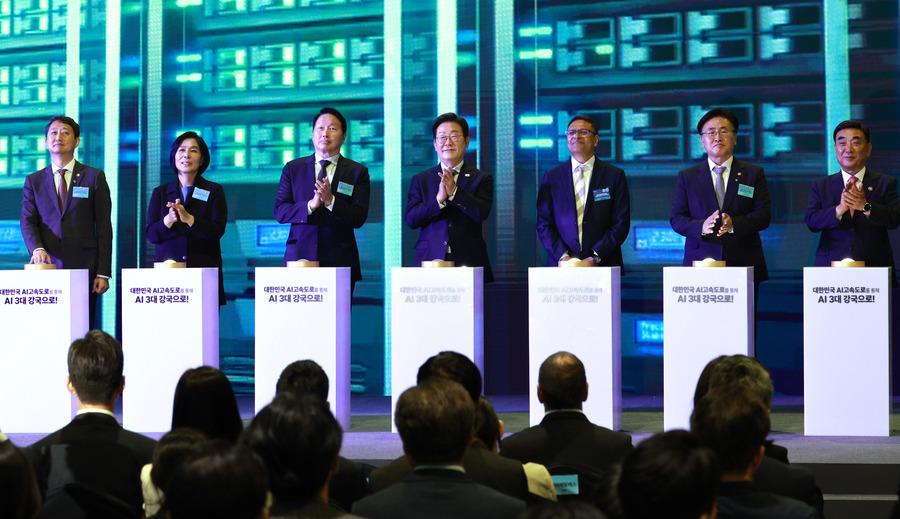
- #South Korea
- #Technology & Cybersecurity

Key Takeaways:
- The U.S. and China are investing heavily, forming alliances around national interests. For Korea, this is no longer a discretionary field, but a strategic imperative.
- Korea’s quantum ecosystem is nascent, facing four major hurdles: (1) talent shortage, (2) hardware limitations, (3) weak startup landscape, and (4) limited presence in global standards and IP.
- By investing decisively, engaging globally, and leading ethically, Korea can secure a meaningful place in the emerging quantum order—transforming technological promise into diplomatic and economic power.
1. Why Quantum Now: From Physics to Geopolitics
Quantum technology, built on the principles of superposition and entanglement, offers capabilities beyond classical limits. Quantum computing enables massively parallel computation, with profound applications in cryptography, drug discovery, and climate modeling. Quantum communication offers near-unbreakable security, while quantum sensing enables ultra-precise measurements in medicine and defense.
Two forces underscore its urgency: technological maturity and global rivalry. Over the past five years, quantum has moved from labs to early commercialization, with cloud platforms like IBM Quantum and Amazon Braket already in use. At the same time, quantum has become a core area of strategic competition, akin to the 21st-century space race. The U.S. and China are investing heavily, forming alliances around national interests. For Korea, this is no longer a discretionary field, but a strategic imperative.
Korea’s quantum capabilities are estimated at 60–70% of global leaders. In 2023, the government designated the “First Year of Quantum Science and Technology,” launching a national strategy with over 3 trillion KRW in projected investment by 2035. The vision includes reaching 85% of leading countries’ tech capacity, training 2,500 professionals, cultivating 1,200 companies, and capturing 10% of the global market.
2. South Korea’s Quantum Ecosystem: Foundations and Gaps
Korea’s quantum ecosystem is nascent, facing four major hurdles:
- Talent shortage: Only a few hundred experts are active in quantum. While graduate programs are emerging at KAIST, POSTECH, and Korea University, the talent base remains shallow compared to peers like China and Japan.
- Hardware limitations: Korea excels in semiconductors but lacks fabrication capabilities for quantum systems, including superconducting and ion-trap qubits. Initial government efforts to build a quantum foundry need private-sector engagement.
- Weak startup landscape: Few quantum startups exist, with most still in seed funding stages. Major chaebols have yet to make strategic investments. Venture capital (VC) risk-aversion exacerbates the “valley of death” in deep tech.
- Limited presence in global standards and IP: Korea holds less than 1% of global quantum patents, trailing far behind China (54%). Active engagement in international standard-setting remains minimal.
Nonetheless, Korea’s ICT infrastructure and strengths in semiconductor offer leverage. Integrating quantum with existing chip platforms and telecom networks could provide a unique edge—if sustained strategic focus is maintained.
3. National Strategy and Governance
Korea has established a cross-ministerial governance system under the Quantum Strategy Committee, chaired by the Prime Minister’s Office. The Ministry of Science and ICT (MSIT) leads basic R&D and talent development. Key initiatives include:
- Quantum Computing Utilization System: Korea’s first physical quantum computer (IBM’s System One) was installed in 2024 at Yonsei University.
- Targeted R&D: The 2025 budget allocates 198 billion KRW to computing, communication, and sensing, with support from KRISS and other institutions.
The Ministry of Trade, Industry and Energy (MOTIE) focuses on commercialization, supporting pilot projects and quantum components through the MPE (Materials‑Parts‑Equipment) program. Defense-related agencies (e.g., ADD, NIS) pursue quantum sensing and secure communications. The Ministry of Education supports graduate programs, while the Ministry of Foreign Affairs advances bilateral and multilateral cooperation, including U.S.-Korea and U.K.-Korea quantum dialogues.
Policy continuity, coordination, and private-sector inclusion are critical to long-term success. The Quantum Strategy Committee must evolve into a true “control tower” for national execution.
4. Strategic Policy Priorities for Quantum Korea
To close the gap with global leaders, Korea must pursue a bold, multifaceted policy approach anchored in four priorities. First, investment must be scaled up, and a dual-track R&D strategy clearly delineated. The current annual budget of approximately 200 billion KRW should be increased to over 500 billion KRW within five years. One track should focus on basic and high-risk research, encouraging failure-tolerant projects and long-term innovations, such as scalable qubit architectures or quantum error correction. The second track should fund application-oriented R&D with market impact within five years—examples include national quantum key distribution (QKD) networks, quantum-enhanced imaging for healthcare, or machine learning algorithms optimized for near-term quantum processors (NISQ devices). This two-tiered strategy ensures both long-term capacity building and short-term relevance to industry.
Second, Korea must adopt a proactive international governance strategy for quantum technology. A national standardization roadmap should outline Korea’s five-year goals for joining and influencing ISO, IEC, and ITU working groups. Specific goals might include developing benchmarking tools for quantum processor performance or contributing to quantum internet protocol standards.
Bilateral and multilateral collaborations should be deepened, particularly with the U.S., EU, and Japan. For instance, Korea could co-develop a post-quantum cryptography (PQC) testbed with NATO partners or pursue mutual patent recognition agreements for standard-essential quantum technologies. These frameworks will not only foster trust, but also provide leverage in global tech diplomacy.
To safeguard national interests, Korea should reinforce its technology security regime. This includes enhanced monitoring of foreign takeovers of quantum-related startups, regulation of critical talent migration, and inclusion of sensitive quantum components in export control lists. These measures must be calibrated to preserve openness with allies while protecting core capabilities.
Korea should also lead ethical discourse on emerging quantum applications. It can propose an internationally endorsed “Ethical Framework for Quantum Technology” that addresses data privacy, military dual-use risks, and AI-quantum convergence. Launching such a framework through UNESCO, the OECD, or even an Asia-Pacific quantum governance forum could establish Korea as a value-driven leader.
Third, building a robust talent and infrastructure ecosystem is essential. Korea should increase graduate school quotas and encourage at least ten universities to offer quantum-related undergraduate programs within five years. Joint PhD programs—e.g., between SNU, KAIST, and industry players—can help aggregate expertise and build interdisciplinary teams.
A national research institute, such as the Korea Quantum Institute (KQI), should be established. This institution would house dedicated divisions in quantum computing, quantum communication, and quantum sensing, operating through university–industry consortia. It can also serve as a central node for international research collaboration, hosting exchange programs, visiting scholars, and multinational projects.
Fourth, the government must take systematic action to stimulate private investment. Korea’s VC environment remains cautious, with limited tolerance for high-risk, long-horizon technologies. A government-backed “Quantum Venture Fund” with patient capital and first-loss protection mechanisms could catalyze more ambitious investments. Additional support could include R&D tax credits, public procurement guarantees, and tech-transfer acceleration programs that help startups move from lab to market. By connecting early-stage startups with testing infrastructure and potential customers—including those in defense, healthcare, and telecom—Korea can reduce barriers to commercialization and foster a vibrant quantum economy.
5. Quantum Korea through Global Alliances
Quantum technology cannot flourish in isolation. It is inherently interdisciplinary and internationally interdependent. For Korea, global cooperation is no longer a strategic option but a necessity—both to accelerate development and to safeguard autonomy.
Korea should approach international collaboration with three distinct objectives. First, alliance-based cooperation enhances systemic resilience. No single country can master every aspect of quantum science and engineering. Collaborative networks with like-minded countries help reduce dependency, ensure interoperability, and provide supply chain security—particularly important for sensitive quantum hardware components.
Second, global partnerships expand Korea’s influence over emerging standards and norms. Active participation in international working groups, tech diplomacy forums, and standard-setting organizations allows Korea to shape the rulebook of future quantum markets. For instance, co-leading an initiative on quantum-safe global infrastructure could place Korea at the center of the next cybersecurity architecture.
Third, strategic partnerships enable co-development of IP and dual-use technologies, especially in areas where individual nations lack sufficient scale. Collaboration with the U.S. or the EU in quantum sensing or post-quantum encryption protocols could accelerate progress while ensuring that Korean firms remain part of global innovation value chains. These alliances can also serve as buffers in times of geopolitical tension, enhancing Korea’s bargaining power.
Importantly, global engagement must go beyond technology. Korea should also invest in soft power strategies—supporting international education exchanges, hosting global quantum forums, and promoting Korean researchers as thought leaders. This contributes to a national brand not just as a technology adopter, but as a visionary architect of the quantum future.
In sum, Korea’s pathway to quantum leadership lies in combining national strategy with international solidarity. By investing decisively, engaging globally, and leading ethically, Korea can secure a meaningful place in the emerging quantum order—transforming technological promise into diplomatic and economic power.

Dr. Dong Hoon Oh earned his B.Sc. in Physics from Korea University and a Ph.D. in Science and Technology Studies from Seoul National University. He previously served as Director-General of R&D Evaluation and Analysis and Director-General of Policy Planning at the Korea Institute of S&T Evaluation and Planning (KISTEP), and worked as Vice President and Partner at Technovation Partners. At the Ministry of Trade, Industry and Energy (MOTIE), he held key positions as Managing Director for Technology Policy and Managing Director for Performance Evaluation and Capitalization of Technology. He also served as a Project Manager at the OECD. He is the author of several books, including 100 Years of Korean Science and Responsible Innovation Nation. In 2018, he founded WISEN Global, where he now serves as Chair of the Board. He is also a Research Fellow at iLAB, Seoul National University. His research focuses on R&D investment strategy, technology scale-up, commercialization, mission-oriented innovation policy (MoIP), and technologies critical to national resilience and survival.


